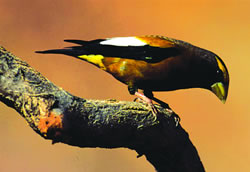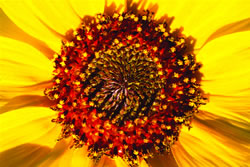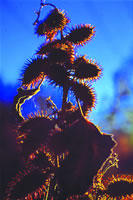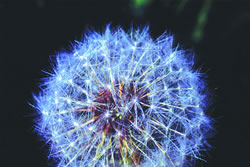Not
only are animals and birds on the move in September,
but so too are summer’s seeds. Unlike wildlife
that uses their feet or wings to get around, seeds
rely on a variety of other transportation options.
 Many
members of the sunflower family have long
fibers or hairs attached to the seeds that
enable the seeds to travel airborne. These
hairs and bristles may form an umbrellalike
structure that provides buoyancy from a slight
wind. Sort of like Mary Poppins’ bumbershoot
when she decides to fly. As the wind settles
down so do the seeds, hopefully landing on
an optimal growing site. The wind may continue
to push these seeds along the ground like
a parachutist trying to collapse their chute.
As the structure starts to break apart, the
seed’s transporting days are limited. Many
members of the sunflower family have long
fibers or hairs attached to the seeds that
enable the seeds to travel airborne. These
hairs and bristles may form an umbrellalike
structure that provides buoyancy from a slight
wind. Sort of like Mary Poppins’ bumbershoot
when she decides to fly. As the wind settles
down so do the seeds, hopefully landing on
an optimal growing site. The wind may continue
to push these seeds along the ground like
a parachutist trying to collapse their chute.
As the structure starts to break apart, the
seed’s transporting days are limited.
Tumbling tumbleweeds, the classic weed of western landscapes,
also rely upon the wind, but with a different intent.
As the plant matures and the seeds ripen, the roots of
this annual plant release their grip on the soil. Autumn’s
wind gets the lightweight plants rolling, literally,
and the plants tumble and bounce across the landscape
like an Olympian gymnast. This tumbling action scatters
the minute seeds.
Lupines use a different method of launching their seeds
away from the mother ship. As the pea pods dry out, they
split along one edge and twist. The release of pressure
within the pod catapults the large seeds. You may notice
the curled and twisted shape of old pods - silent testimony
to this “snappy” dispersal method.
 Of
course, wildlife also engage in transporting
seeds via direct or indirect methods. Direct
methods include ingesting berries or fruits
and pooping out the indigestible seeds. Not
only are the seeds carried away from the host
plant, but also are deposited in their own
fertilizer! One September while hiking in Seven
Mile Canyon, I found numerous coyote and bear
scats that were stained eggplant purple and
loaded with the tiny black seeds of Fremont’s
mahonia. Of
course, wildlife also engage in transporting
seeds via direct or indirect methods. Direct
methods include ingesting berries or fruits
and pooping out the indigestible seeds. Not
only are the seeds carried away from the host
plant, but also are deposited in their own
fertilizer! One September while hiking in Seven
Mile Canyon, I found numerous coyote and bear
scats that were stained eggplant purple and
loaded with the tiny black seeds of Fremont’s
mahonia.
Another direct method is the carry-and-cache mode. Acorns,
grasses and pine nuts seem to be the primary recipients
of this process. Pinyon jays, ground squirrels, Clark’s
nutcrackers, and small rodents collect the seeds or nuts
and hoard them in underground burrows. Some of these
caches are visited later in the fall or winter. Those
that are either forgotten or left alone may sprout forming
new plants in the spring.
 The
indirect method of seed transport is due to
seeds or fruits clinging to the feet or fur
of animals and becoming dislodged at some point
along the way. Cockleburs, certain grasses,
blazing stars, jimsonweed, and members of the
borage family have projections or spines on
either the seed’s coat or the fruiting
capsule that enables them to hitch a ride.
This attachment concept works so well, that
cockleburs are given credit for the creation
of Velcro®. The
indirect method of seed transport is due to
seeds or fruits clinging to the feet or fur
of animals and becoming dislodged at some point
along the way. Cockleburs, certain grasses,
blazing stars, jimsonweed, and members of the
borage family have projections or spines on
either the seed’s coat or the fruiting
capsule that enables them to hitch a ride.
This attachment concept works so well, that
cockleburs are given credit for the creation
of Velcro®.
Although there is no guarantee that these seeds will
land in a favorable spot to germinate, they do have an
addition advantage – longevity. Many desert seeds
will lie dormant hidden beneath the soil surface for
just the right set of germination conditions. Even after
many years, the seeds remain viable.
For a fun experiment with kids, collect some dandelion
seeds and have one person release them from a standing
point. The other person places markers – stones,
Popsicle sticks, twigs – where they land and measure
how far these seeds travel.

|